How Live Shopping Meets Consumers' Needs for Human Interaction in eCommerce
iAdvize

Nearly every transaction starts or ends online. And most of us value the convenience and choice e-commerce offers.
But the truth is shopping online can seem like an analytical exercise instead of evoking emotions of excitement and enjoyment. Digital commerce can feel decidedly anonymous and lack a personal touch.
That lack of a personal touch is one reason why some people choose to stick with in-store shopping. Case in point: Chain Store Age reported that nearly half of all shoppers say they prefer to shop at brick-and-mortar stores, despite a widespread shift to digital in 2020.
One-third said they prefer the opportunity to view and interact with physical products, while 26% appreciate the overall experience of in-store shopping. The opportunity to seek help and get advice when needed from in-store associates is another advantage of physical retail.
There's no question that digital shopping is a different experience all around, and technology will always come into play. But today's you can capture some of the magic with live shopping. You can create human, personal experiences that shoppers will remember.
Shoppers Want to See a Person Behind the Product
The desire for human interaction is part of the experience of being human, and shopping is one way to fulfill this core need. However, research published in the Harvard Business Review (HBR) explains that shopping has largely become a de-personalized experience. Not only can people browse and buy online, but consumers may also opt for automated checkouts when they do visit stores.
While efficiency matters--both to brands and shoppers--psychologist and HBR author Adam Waytz says companies may be missing out on the power of human interaction. He asserts that a human-centered focus imparts social and emotional benefits, but also increases the perceived value of products and experiences:
A human touch also imbues experiences and products with special significance and thus increases peoples' perception of the value of those experiences and products. Smart organizations, rather than continuing to automate their services at all costs, would be wise to understand the ways that human presence creates value in the mind of consumers.Adam Waytz, Psychologist and HBR Author
According to Waytz, human-centered shopping interactions deliver three qualities that make them valued by consumers:
- Intent: People want to know that the experiences they have with companies are driven by human agency, not anonymous automation. Psychological studies show that people attribute more value to items intentionally selected for them and have positive sentiments about handmade goods that give the impression of being created with intent and care.
- Effort: People appreciate knowing that others put effort into bringing products to them. For example, psychological research found people responded more favorably to language stating that products were made by humans in a factory than simply made in a factory. Knowing that someone has taken the time to help them access products makes a meaningful impression on studies.
- Authenticity: People appreciate knowing that people value and use products in their everyday lives. That's one of the reasons why online reviews are such a powerful force in shaping consumer decision-making. It's much easier to feel confident in a trusted person's or peer's opinion about a product than a brand message.
What does this mean for brands? Understanding that shoppers value seeing the people behind the products and others who use them is essential to creating meaningful experiences for customers. This isn't as straightforward online, as technology always is an intermediary. But live shopping can bridge the gap.
How Live Shopping Fulfills Critical Shopper Needs
While we like to believe all our purchase decisions are purely rational, we're all driven by our emotions. How we feel about brands influences whether we buy from them at all, and if so, how much. As digital commerce rose to prominence, so did design-intensive interfaces, pages of product data, and a push to click here and buy now. Those features did nothing to fulfill our needs for human interaction and connection.
At the same time, the internet has become a space for socialization and interaction, with video-watching taking over as a top pastime. Live shopping sits at the nexus of these trends and provides a novel way to connect with people and fulfill their emotional needs.
Support for High-Consideration Purchases
We all buy some essential, everyday goods without much thought. But if we're purchasing complex or expensive items, we'll likely spend more time researching and analyzing options to make an informed decision. Also, we may take their time to weigh purchases for highly personal items like apparel or cosmetics. Often, brands may need to provide support or advice on these types of high-consideration purchases.
What's the key to driving a high-consideration purchase forward? According to research from TD Bank, it's not all about money. Fifty-four percent (54%) of people say they look at factors other than cost, up from 41% in 2021.
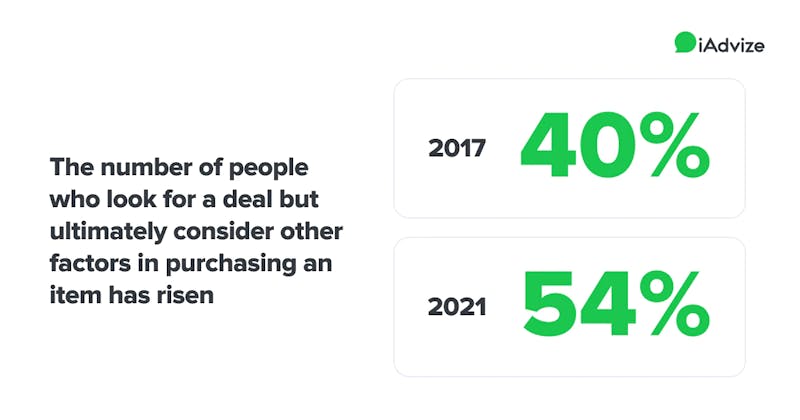
What's a top factor for consumers? Ninety-two percent (92%) of shoppers say they'll buy from retailers they trust. Another thing to know: Shoppers like to be well informed, with 94% researching before making a high-consideration purchase.
Live shopping is one of the best ways to address your consumers' needs for trust and informed decision-making. During a live shop, people get the opportunity to see products, ask questions, and engage with both hosts and a community for real-world advice. Instead of the guesswork that often accompanies online shopping, your customers can feel informed and confident about their choices.
Since our own research found that 55% of high-intent shoppers abandon purchases due to a lack of confidence, this boost can deliver gains to your bottom line.
Feeling confident about purchases mitigates another common problem — buyer's remorse. Shoppers want to feel like they've acquired the right product for the right price, and it's easy to second-guess themselves.
However, according to ClickZ, people feel better if they have an opportunity to share their purchase with others: In its report on The Psychology of High-Consideration Purchases, ClickZ says, "if you want people to enjoy their product more, give them the opportunity to share it immediately, and perhaps they won’t have that buyer’s remorse — they’ll actually feel they’ve enjoyed it more."
Live shopping lets you do just that. People can see purchase tallies climb and chat with other buyers to share their excitement. Instead of being left alone to wonder if they've made a wise choice, your shoppers can feel bolstered by the positive opinions of others and feel good about their purchase — and your brand.
Authentic Peer-to-Peer Experiences
It's a well-known fact that people are more inclined to trust word-of-mouth recommendations when making buying decisions. And shoppers trust advertising and other corporate messages least of all.
A recent consumer study from Marketing Charts confirms this presumption. Just 38% percent of people say they trust advertising. The most relied-upon sources of insight are friends and family at 93%, followed closely by reviews at 91%. Other company-sponsored earn far less trust.
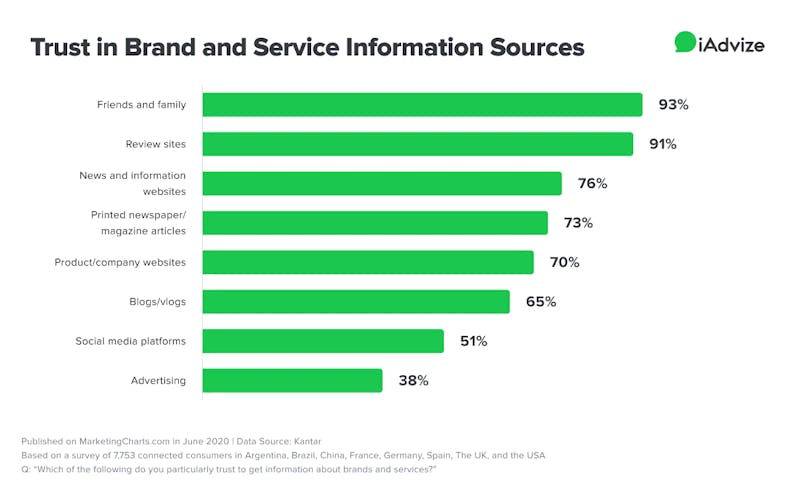
Live shopping aligns with consumer desires to gain insight from word-of-mouth (WOW) sources. The reason? Live events aren't designed as one-way communications with the brand as the sender of information and viewers as receivers. Further, while live shopping allows two-way communication by letting shoppers ask questions and provide products to brands, it doesn't stop there.
In fact, brands can think of live shopping as a powerful, real-time form of peer-to-peer (P2P) marketing. During a live event, shoppers can talk with each otter, answer product or brand questions, and give in-depth perspectives on how products may fit into others' day-to-day lives. This authentic information can feel immensely valuable or trustworthy. After all, another person on a live stream is not likely to be earning a commission for promoting the brand but instead sharing a genuine opinion about the products on sale.
No doubt, one shopper helping another person out with answers or advice is valuable, but brands can get more mileage out of such comments. Moderators can identify positive endorsements from viewers during the event and showcase them on screen or bring them to the host's attention to increase their visibility. That way, the whole audience can get authentic feedback from a fellow viewer and peer — input that can go a long way towards motivating purchases.
The power of peer-to-peer marketing isn't new. More than a decade ago, McKinsey & Company reported that word-of-mouth marketing was the driving force behind 20% to 50% of all purchasing decisions. What's more, McKinsey found that word-of-mouth was most influential when shoppers were buying new products for the first time or purchasing expensive items because both situations require more research.
Instead of taking days or weeks to conduct research, live shopping can significantly shorten the customer buying journey. Shoppers who sign on can get immediate answers from people like them, make purchases on the spot, and feel excited about what they bought.
Memorable Experiences
Over two decades ago, a groundbreaking Harvard Business Review article suggested that we were entering a new "experience economy." Authors B. Joseph Pine II and James H. Gilmore described an experience this way:
An experience occurs when a company intentionally uses services as the stage, and goods as props, to engage individual customers in a way that creates a memorable event.B. Joseph Pine II and James H. Gilmore, Authors of "The Experience Economy"
Recent years have shown the truth behind the experience economy premise. While we're always going to engage in quick trips to the grocery store or pharmacy, we're looking for something more from brands. That's why some brands have created experiential stores or immersive in-person events to cater to people's needs to have great experiences and share them with others.
Live shopping is the online counterpart to these types of brick-and-mortar venues. By providing a fun, high-energy event that lets people connect with other fans of the brand, companies offer shoppers the one-of-a-kind experience they crave. Plus, when brands include a popular influencer as a host, shoppers can join for the excitement of connecting with a favorite online personality. The result is something they won't soon forget.
Importantly, research from Gartner shows positive benefits to brands who do stand out in digital shoppers' minds. A 2020 survey found that nearly half of all customers couldn't differentiate between the digital experiences offered by most brands, and just 14% of digital experiences influenced buying behavior.
However, when experiences motivate shoppers to take action -- such as making a purchase or sharing the brand with others -- that creates a 37% increase in brand preference and a 54% increase in brand advocacy. The takeaway: Creating a standout live shopping experience can drive loyalty and motivate shoppers to share your brand with others.
A Sense of Community
People are social creatures, and we all want to feel like we belong. Innovative companies have been tapping into that innate need by building communities that connect people who identify with and want to share information about the brand. For consumers, branded communities are valuable sources of information and relationship-building with like-minded others. And for retailers, communities become a springboard for innovation and an opportunity to grow brand evangelism.
Live shop events can help members of your community sync up in real-time and help you draw others to the fold. The truth is, your customers and brand loyalists want you to help them forge connections with others.
Here are some insightful statistics from a recent consumer study:
- 78% of consumers want brands to take an active role in helping people connect with each other
- 64% of people want brands to connect with them
- 55% want brands to help them connect with like-minded people
- 46% of people want brands to bring people from different backgrounds together
Another key finding from another study, 52% of people of all ages agree that they could be motivated to join a brand community.
The message is clear. People want companies to help them engage with other brands aficionados. You may always need a social group or online forum for ongoing discussions by customers. But a live shop can give your community a way to bridge digital barriers and deepen their relationships with each other — and that can mean feeling stronger ties to your brand.
Humanizing the Digital Experience with Live Shopping
While brands will always measure performance using numbers and data, we should never lose sight of the truth that the customers behind our success are people. And people have an innate need to connect with others — to build relationships and feel part of a community.
Another essential truth: We live in an era where experiences matter and must cater to customers who are more and more likely to choose experiences over things. And the experiences brands deliver online are just as important as the ones they provide in-store — perhaps even more so.
What does that mean for you? Instead of an anonymous online presence, you should look to distinguish yourself by providing experiences that align with digital shoppers' needs for human interaction. Live shopping lets you achieve that goal.
A live shop lets people get the information they need to make high-consideration purchases, both from brand experts and peers. Each event will be truly unique, with different products, hosts, and contributions from the viewer community. You can foster positive memories, goodwill, and a sense of belonging, which will all encourage shoppers to keep coming back.
We all know customer loyalty is good for business, and data proves this truism valid again and again. One recent metric: 57% of people say they'd spend more with brands with whom they feel a strong connection. Another telling fact is that nearly 40% of people say they'll stay with a brand with which they have a connection — even after a bad experience.
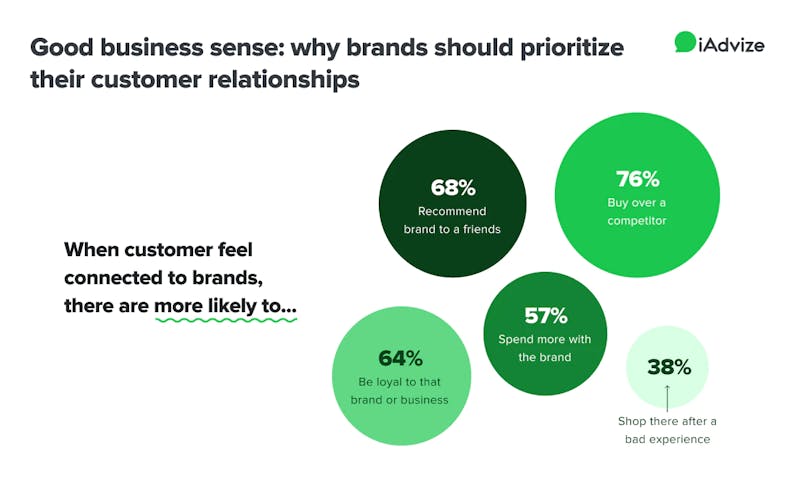
Building a sense of human connection with customers online is essential in today's digital world. And live shopping is the game-changing opportunity that can accelerate your digital relationship-building efforts.
With live shopping just gaining a foothold in the U.S., you can act swiftly to capture shopper interest and get ahead of the curve. Solidifying your role as a people-centric innovator in retail's next chapter is a clear way to position yourself for ongoing success.
Ready to dive into live shopping? Let iAdvize be your guide. Dozens of top-name brands have used our Aploze platform to deliver immersive, interactive shopping experiences to their audiences. Our live shop experts will coach you every step of the way! Get started today.

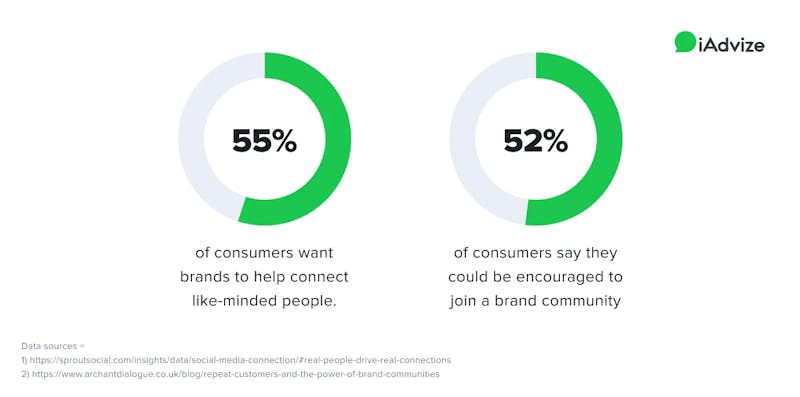
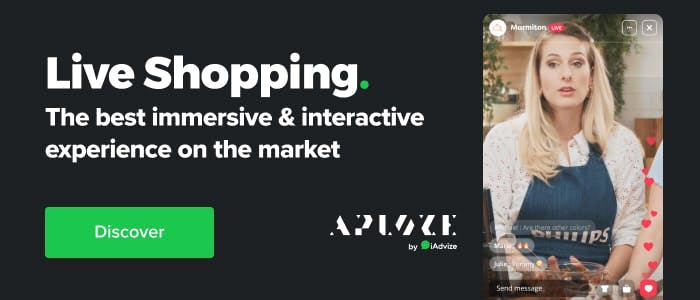
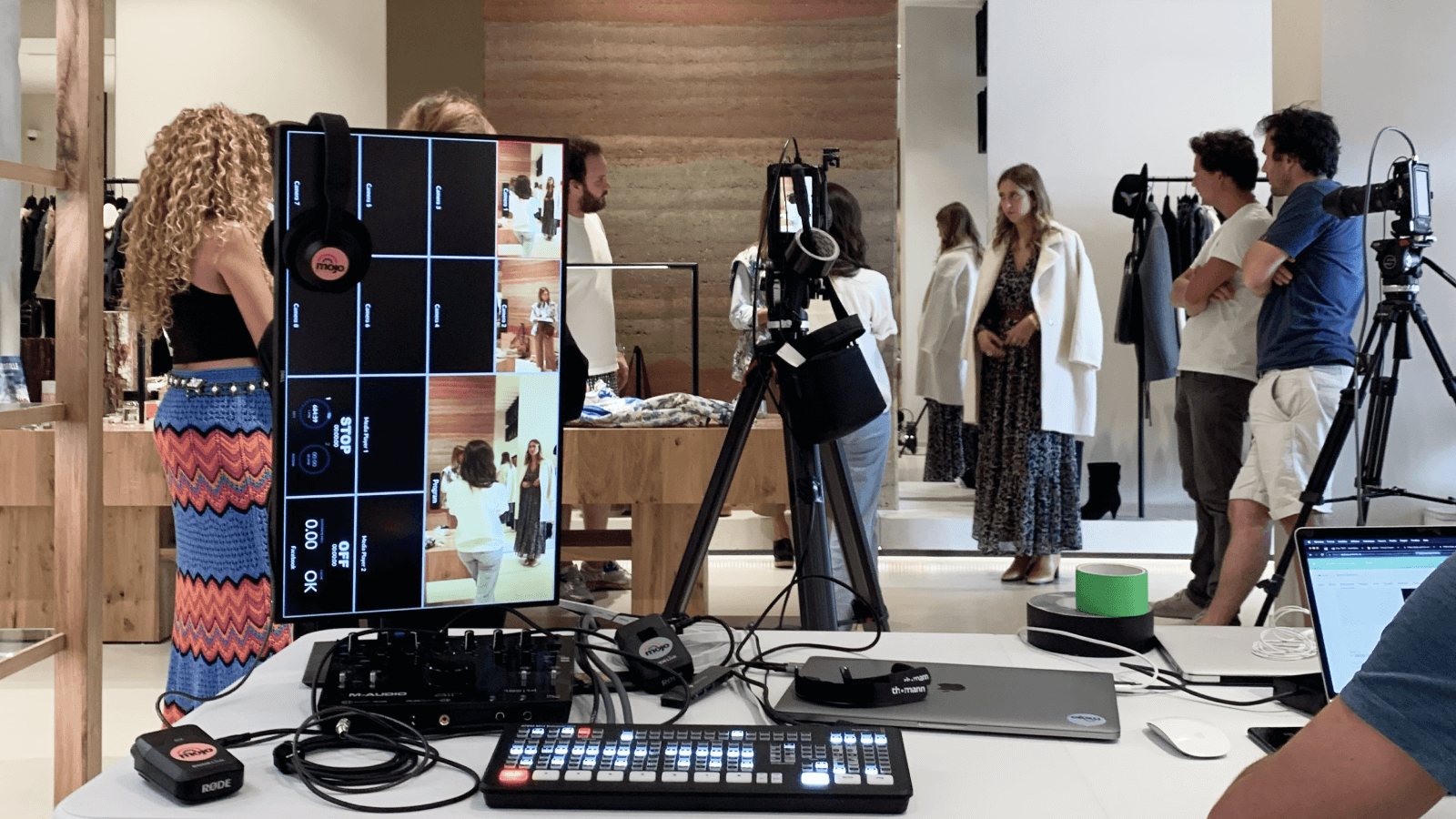

.png)



